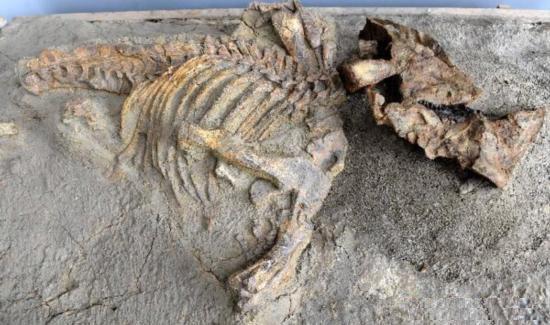 |
|
Holotype of Sinoceratops Zhuchengensis, a ceratopsid dinosaur from Upper Cretaceous deposits in Zhucheng, Shandong Province, China (Courtesy of Dr. XU) |
Dr. XU Xing, Institute of Vertebrate Paleontology and Paleoanthropology, Chinese Academy of Sciences, and his collaborators have identified a new ceratopsid dinosaur- Sinoceratops Zhuchengensis, from Upper Cretaceous deposits in Zhucheng, Shandong Province, China, as reported in the recent issue of Chinese Science Bulletin.
Fossils of the dinosaur were unearthed in January 2008 in Zhucheng City, where several Cretaceous dinosaurs have been found since the 1960s, "but was identified only quite recently," said Dr. XU Xing, "Its skull is at least 180 cm long and 105 cm wide," said Xu. "It has a 30-cm long horn on its face and at least 10 crooked, smaller horns on the top of its head."
Ceratops (meaning horn face) were large, plant-eating dinosaurs of the late Cretaceous period that dates to back more than 65 million years ago. The most renowned ceratops is triceratops, a huge herbivore weighing over 10 tonnes.
The discovery of the Zhuchengensis might rewrite current theories on the morphological transition among dinosaurs. "It blurs the distinctions between two types of ceratops," said Dr. XU Xing, "It bears features of centrosaurus, a group of ceratops, that are smaller in size, but its size resembles chasmosaurus, the giants of ceratops."
Before China's finding, ceratops had been unearthed only in western North America.
Dr. XU Xing and his colleagues said the discovery provided proof that supported the hypothesis of the horned dinosaurs' migration from Asia to North America.
Chinese scientists have found at least 10 dinosaur species in Zhucheng City in three rounds of excavation since the 1960s including Tyrannosaurus and Hadrosaurs.
Related News
Photos
More>>trade
market
- Speeding up Electrons in Solar Cells
- IVPP Research Ranks among Discover Magazine's Top 100 Science Stories of 2010
- Advances of Cranial Morphology of Silurian Sarcopterygian Guiyu Oneiros
- IHEP and FECO Sign Framework Agreement on Mercury Technology Cooperation
- First Single-fingered Dinosaur Found in Inner Mongolia, China





